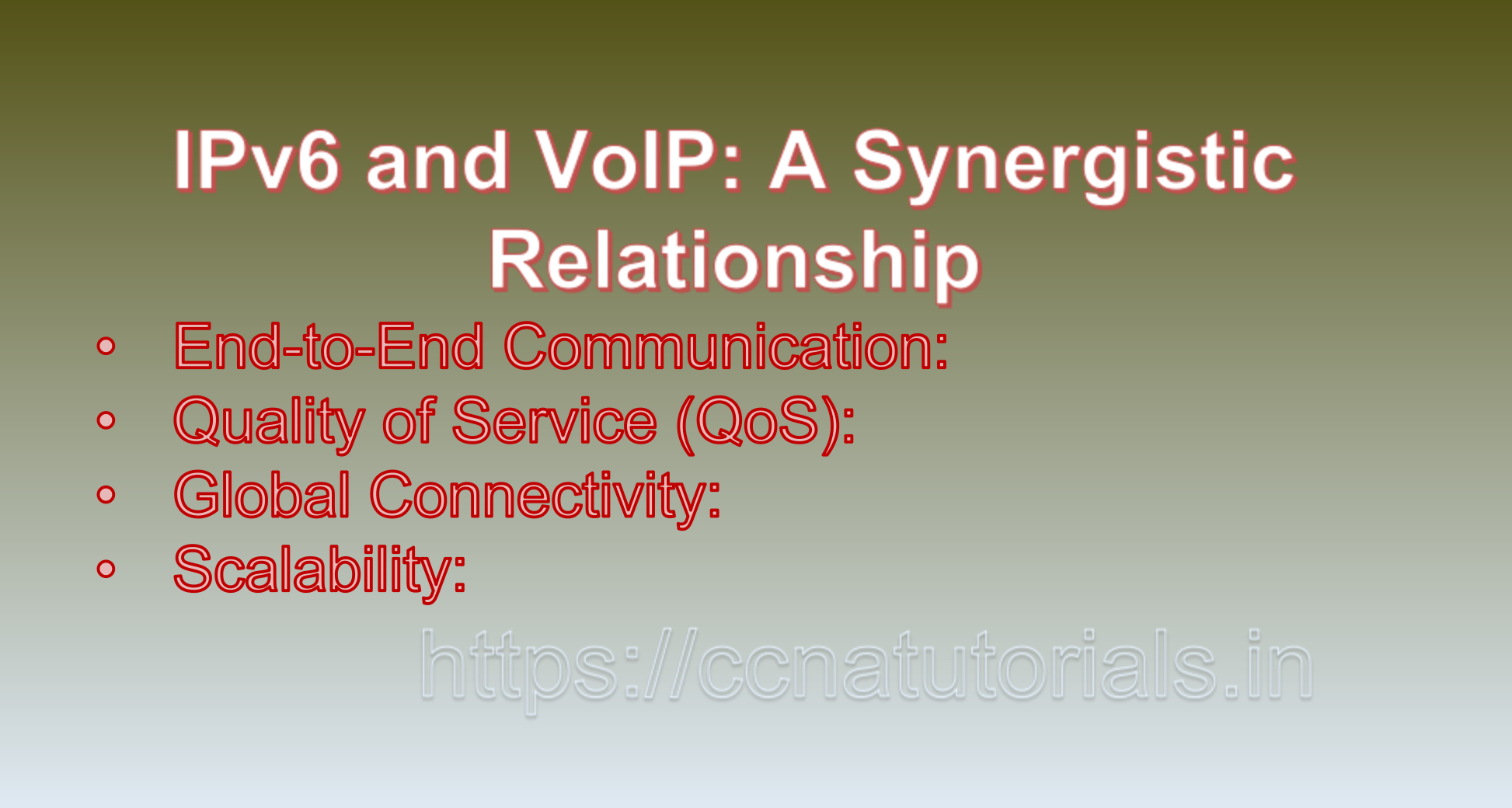Contents of this article
IPv6 and Voice over IP (VoIP): Revolutionizing Communication in the Digital Age. In the realm of modern communication, both IPv6 (Internet Protocol version 6) and Voice over IP (VoIP) stand as transformative technologies that have reshaped the way we connect and communicate. IPv6 offers an expansive address space to accommodate the growing number of devices, while VoIP enables voice communication over the internet, transcending traditional telephony. In this article, we will explore the symbiotic relationship between IPv6 and VoIP, their benefits, real-world examples, and their collective impact on revolutionizing communication in the digital age.
Understanding IPv6 and Voice over IP (VoIP)
IPv6: IPv6 is the next generation of the Internet Protocol, designed to address the limitations of its predecessor, IPv4. It introduces a larger address space and enhanced features to accommodate the exponential growth of connected devices in an increasingly interconnected world.
VoIP: Voice over IP, commonly known as VoIP, is a technology that enables voice communication and multimedia sessions over the internet. Unlike traditional telephony that relies on dedicated circuits, VoIP transforms analog voice signals into digital data packets that are transmitted using internet protocols.
IPv6:
1. Address Space:
IPv6 offers a massive address space of 128 bits, allowing for an almost unlimited number of unique IP addresses. This is essential for accommodating the myriad of devices, including smartphones, tablets, IoT devices, and more, all requiring distinct addresses.
2. End-to-End Connectivity:
IPv6 supports direct end-to-end communication between devices, eliminating the need for Network Address Translation (NAT) and enabling more efficient and direct connections.
3. Autoconfiguration:
IPv6 includes features like Stateless Address Autoconfiguration (SLAAC), making it easier for devices to configure themselves on the network, even in dynamic and mobile environments.
VoIP:
1. Cost-Efficiency:
VoIP significantly reduces communication costs compared to traditional telephone systems, especially for long-distance and international calls.
2. Flexibility:
VoIP can be used on various devices, including computers, smartphones, tablets, and even specialized VoIP phones. This versatility empowers users to communicate from virtually anywhere with an internet connection.
3. Rich Media Integration:
VoIP enables the integration of other media types, such as video conferencing, instant messaging, and file sharing, enriching the communication experience.
IPv6 and VoIP: A Synergistic Relationship
The adoption of IPv6 has played a pivotal role in enabling the widespread implementation of VoIP. The marriage of these technologies has resulted in numerous benefits and capabilities that shape modern communication.
1. End-to-End Communication:
IPv6’s support for direct end-to-end communication aligns perfectly with the peer-to-peer nature of VoIP. This means that VoIP calls can occur without intermediaries, reducing latency and enhancing call quality.
2. Quality of Service (QoS):
IPv6’s QoS mechanisms, coupled with VoIP, enable prioritization of voice traffic over the network, ensuring that voice packets are treated with higher priority and reduced delay.
3. Global Connectivity:
With IPv6, VoIP providers can deploy globally accessible communication services, providing users with the ability to make and receive calls from anywhere in the world with an IPv6-enabled device.
4. Scalability:
IPv6’s abundant address space supports the scaling of VoIP services to accommodate the growing user base and the increasing number of connected devices.
Examples Illustrating IPv6 and Voice over IP (VoIP)
1. Business Communication:
A multinational corporation adopts IPv6 to ensure sufficient address space for its plethora of connected devices. Simultaneously, it deploys a VoIP solution for seamless, cost-effective communication between its various branches and remote employees. The combination of IPv6 and VoIP allows the company to connect its global workforce without geographical barriers.
2. Home VoIP Services:
A household adopts IPv6-enabled devices, including smartphones and tablets. They also subscribe to a VoIP service provider. When family members are away from home, they can make and receive VoIP calls using their devices over IPv6-enabled networks, eliminating the need for traditional phone lines.
3. Telehealth Services:
A healthcare provider integrates IPv6 and VoIP to offer telehealth services to patients. Patients can consult with medical professionals remotely using VoIP calls, discussing medical concerns and receiving advice, all over secure IPv6 connections.
Short description of IPv6 and Voice over IP (VoIP)
The convergence of IPv6 and VoIP has redefined the landscape of communication, enabling seamless, cost-effective, and versatile connectivity on a global scale. IPv6 addresses the limitations of address space, ensuring that the growing multitude of devices can connect without hindrance. VoIP transforms voice communication into a digital medium, enhancing collaboration and transcending geographical boundaries. As these technologies continue to evolve, they collectively empower businesses, individuals, and industries to communicate in ways that were once unimaginable. In the digital age, IPv6 and VoIP stand as catalysts for change, revolutionizing the way we interact and communicate.

IPv6 and Voice over IP (VoIP): Transforming Communication in the Digital Age
The integration of Internet Protocol version 6 (IPv6) and Voice over IP (VoIP) technology has revolutionized communication by enabling voice calls to be transmitted over internet networks. This innovative combination offers numerous benefits, including enhanced call quality, cost savings, and seamless global connectivity. In this article, we will explore the synergy between IPv6 and VoIP, their advantages, considerations, and provide examples to illustrate their significance in modern communication.
Understanding IPv6 and VoIP: An Overview
IPv6: IPv6 is the successor to IPv4, designed to address the limitations of the older protocol by providing a vastly larger address space and improved features. With the proliferation of connected devices, IPv6 ensures that there are enough unique IP addresses to accommodate the growing number of devices in the digital world.
VoIP: VoIP, or Voice over IP, is a technology that enables voice communication and multimedia sessions to be transmitted over IP networks, such as the internet. VoIP converts analog voice signals into digital data packets and uses network protocols to transmit these packets.
Benefits of IPv6 and VoIP Integration
1. Enhanced Call Quality:
IPv6’s larger address space and optimized routing reduce network congestion, leading to improved call quality and lower latency in VoIP communication.
2. Global Connectivity:
IPv6’s abundant address pool supports the global expansion of VoIP services, allowing users from different regions to connect seamlessly.
3. Cost Savings:
VoIP communication leverages existing internet infrastructure, significantly reducing long-distance calling charges and making international communication more cost-effective.
4. Rich Multimedia Services:
The integration of IPv6 and VoIP facilitates the transmission of multimedia content, including video conferencing and file sharing, enhancing collaboration.
5. Mobility:
IPv6 supports mobile devices more effectively, enabling VoIP calls to be made from smartphones, tablets, and other mobile devices.
IPv6 and VoIP Implementation Considerations
IPv6 Deployment:
1. Network Readiness:
Organizations need to ensure that their network infrastructure supports IPv6 to facilitate seamless VoIP communication.
2. Dual-Stack Architecture:
A dual-stack network configuration allows devices to communicate using both IPv4 and IPv6, ensuring compatibility during the transition period.
3. VoIP Equipment Compatibility:
VoIP hardware and software must be IPv6 compatible to ensure smooth communication across networks.
VoIP Implementation:
1. Quality of Service (QoS):
VoIP traffic requires priority over other types of data to maintain call quality. Implementing QoS mechanisms ensures optimal voice transmission.
2. Security:
Securing VoIP communication is crucial to prevent eavesdropping, data breaches, and denial-of-service attacks. Encryption and authentication mechanisms must be employed.
3. Firewall and NAT Traversal:
VoIP packets may encounter issues when traversing firewalls or Network Address Translation (NAT) devices. Solutions like Session Traversal Utilities for NAT (STUN) and Interactive Connectivity Establishment (ICE) can address these challenges.
Examples Illustrating IPv6 and VoIP Integration
1. Global Business Communication:
Imagine a multinational corporation with offices in different countries. By integrating IPv6 and VoIP, the company can:
– Use IPv6 to facilitate efficient communication between offices worldwide.
– Implement VoIP technology for international calls, saving costs compared to traditional telephony.
– Host virtual meetings and video conferences, utilizing IPv6’s capacity for multimedia services.
2. Mobile VoIP:
Consider a traveler using a VoIP app on their smartphone to make international calls. The integration of IPv6 allows for:
– Seamless VoIP communication while switching between different networks, ensuring connectivity.
– High-quality voice calls with reduced latency due to IPv6’s efficient routing.
3. Remote Work Collaboration:
With the rise of remote work, VoIP communication becomes essential. Integrating IPv6 and VoIP enables:
– Remote teams to collaborate effectively through voice and video calls.
– Scalable communication solutions that accommodate the increased demand for remote work tools.
Conclusion for IPv6 and Voice over IP (VoIP)
The integration of IPv6 and VoIP technology has transformed the way we communicate, offering enhanced call quality, global connectivity, cost savings, and new avenues for collaboration. IPv6’s expansive address space and optimized routing contribute to seamless VoIP communication, while VoIP technology takes advantage of IPv6’s capabilities for efficient multimedia services. As organizations and individuals continue to adopt these technologies, the synergy between IPv6 and VoIP will play a vital role in shaping the future of communication by providing reliable, scalable, and cost-effective voice and multimedia services across the globe. You may comment below or contact us for any query related to this article.






